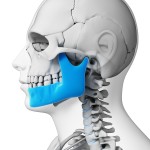
Temporomandibular joint disorders (TMD) are normally managed conservatively however it has been estimated that aroung 5% require a surgical interventions (arthrocentesis, arthroscopy, condylotomy, and disc repair or removal (menisectomy). A small subset of patietsn may require Temporomandibular Joint (TMJ) replacement . Indications for replacement include:-
- bony ankylosis
- failed previous alloplastic and autogenous joint replacement
- post-traumatic condylar degeneration
- avascular necrosis, post-tumour reconstruction
- developmental abnormalities
- functional deformity
- severe inflammatory conditions that have failed to resolve with non-surgical management.
The aim of this Health Technology Assessment was to perform a review and critical appraisal of the published primary research concerning the safety and effectiveness of TMJ Concepts® and Biomet® Microfixation TMJ prostheses for adult patients who are indicated for total TMJ replacement.
Literature searching of a wide range of databases was conducted restricted to the period between 2000-2011. Randomised or non-randomised controlled trials, cross-sectional, cohort or case- control designs, single group pre-post designs, and case series studies in English, German, Spanish or Chinese were considered.
- 9 studies, all case series were included, 5 were prospective, four retrospective
- Five studies assessed the TMJ Concepts® custom prosthesis, three assessed the Biomet® Microfixation prosthesis (two studies examined the stock prosthesis and one the patient-matched prosthesis), and one study reported combined outcomes for a group with either a TMJ Concepts prosthesis or a Biomet Microfixation stock prosthesis.
- All studies were considered to suffer from a number of methodological shortcomings. Qualitative summaries of the included papers and the various outcomes considered are discussed
The authors concluded
TMJ replacement is a last-chance procedure for those with the most advanced and debilitating forms of TMJ derangement.
Evidence from nine case series studies indicates that total TMJ replacement provides patients with stable improvement in incisal opening, jaw and diet function, and reduced pain for at least up to two years. The same studies indicate minimal risk of serious adverse events over the same time period. Given the relatively young age of TMJ prosthetic replacement recipients, evidence on the long-term effectiveness and need for additional TMJ prostheses over a patient’s lifetime would be useful. No evidence is available regarding the cost-effectiveness of total TMJ replacement, but it is likely that it is associated with improved health outcomes at additional costs. In the absence of being able to estimate the actual incremental cost-effectiveness of TMJ replacement and compare that to the next best alternative use of the resources, no judgment can be made regarding whether the additional health benefit is worth the additional cost. At current volumes, the budget impact of total TMJ replacement is, at most, $581,085; however, the budget impact would be greater if capacity were increased to meet the current demand.
Comment
This health technology assessment review was conducted for Alberta Canada so the indicated costs will be different in other health systems. The authors of this review note the main limitation of this report was the paucity of information provided in the studies on surgeon training and experience . The UK National Institute for Health and Clinical Excellence (NICE) reviewed this procedure in 2009 and came to similar overall conclusions in that,
While there is evidence that this procedure works well in the short and medium term, there is not much good evidence about how well it works and how safe it is in the long term.
Links
